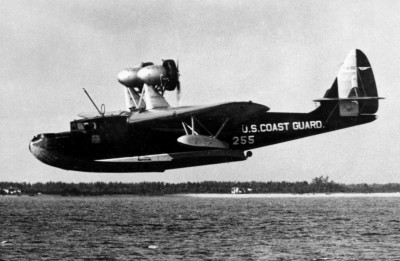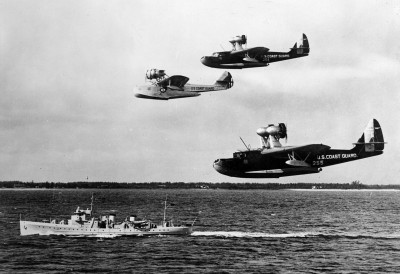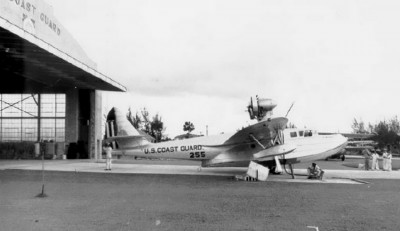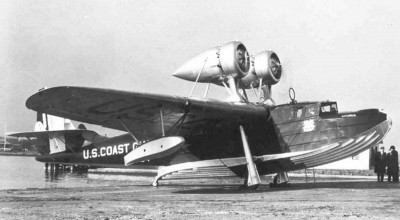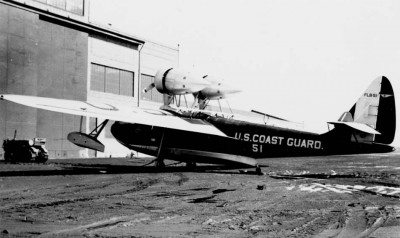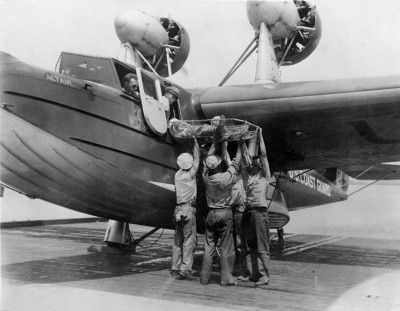| Název: Name: | General Aviation PJ-1 | General Aviation PJ-1 |
| Originální název: Original Name: | General Aviation PJ-1 | |
| Kategorie: Category: | záchranný letoun | search and rescue aeroplane |
| Výrobce: Producer: | DD.MM.1931-DD.MM.1932 General Aviation Corp., Hasbrouck Heights, New Jersey | |
| Období výroby: Production Period: | DD.MM.1931-DD.MM.1932 | |
| Vyrobeno kusů: Number of Produced: | 5 | |
| První vzlet: Maiden Flight: | DD.MM.1931 | |
| Osádka: Crew: | 4 | |
| Základní charakteristika: Basic Characteristics: | ||
| Vzlet a přistání: Take-off and Landing: | CTOL - konvenční vzlet a přistání | CTOL - conventional take-off and landing |
| Uspořádání křídla: Arrangement of Wing: | jednoplošník | monoplane |
| Uspořádání letounu: Aircraft Concept: | klasické | conventional |
| Podvozek: Undercarriage: | pevný | fixed |
| Přistávací zařízení: Landing Gear: | člunový trup | flying boat |
| Technické údaje: Technical Data: | ||
| Hmotnost prázdného letounu: Empty Weight: | 3175 kg | 7000 lb |
| Vzletová hmotnost: Take-off Weight: | ? kg | ? lb |
| Maximální vzletová hmotnost: Maximum Take-off Weight: | 5080 kg | 11200 lb |
| Rozpětí: Wingspan: | 22.61 m | 74ft 2in |
| Délka: Length: | 16.76 m | 55ft |
| Výška: Height: | 4.72 m | 15ft 6in |
| Plocha křídla: Wing Area: | 70.05 m2 | 754 ft2 |
| Plošné zatížení: Wing Loading: | ? kg/m2 | ? lb/ft2 |
| Pohon: Propulsion: | ||
| Kategorie: Category: | pístový | piston |
| Počet motorů: Number of Engines: | 2 | |
| Typ: Type: | Pratt & Whitney R-1340C-1 Wasp o výkonu 336 kW dvoulistá kovová na zemi stavitelná vrtule | Pratt & Whitney R-1340C-1 Wasp, power 420 hp two-bladed ground-adjustable metal propeller |
| Objem palivových nádrží: Fuel Tank Capacity: | 1666 l | 440 US gal |
| Výkony: Performance: | ||
| Maximální rychlost: Maximum Speed: | 209.2 km/h v ? m | 130 mph in ? ft |
| Cestovní rychlost: Cruise Speed: | ? km/h v ? m | ? mph in ? ft |
| Rychlost stoupání: Climb Rate: | ? m/s | ? ft/min |
| Čas výstupu na výšku: Time to Climb to: | ? min do ? m | ? min to ? ft |
| Operační dostup: Service Ceiling: | 2743 m | 9000 ft |
| Dolet: Range: | 1850.7 km | 1150 mi |
| Maximální dolet: Maximum Range: | ? km | ? mi |
| Výzbroj: Armament: | - | - |
| Uživatelské státy: User States: | | |
| Poznámka: Note: | - | - |
| Zdroje: Sources: | Johnson, E. R. United States Naval Aviation, 1919-1941. McFarland, Jefferson 2011. ISBN 978-0-7864-4550-9. Johnson, E. R. American Flying Boats and Amphibious Aircraft: An Illustrated History. McFarland, 2009. ISBN 0786439742. Swanborough, G., Bowers, P. M. United States Navy Aircraft since 1911. Putnam Aeronautical Books, London 1990, ISBN 0-85177-838-0. http://www.aerofiles.com/_fok.html www.flightglobal.com www.flightglobal.com | |
General Aviation PJ-1
General Aviation FLB
General Aviation FLB began in 1930 as Fokker model F. 15, designed according to the requirement of the u.s. coast guard twin-engine aircraft for rescue tasks on the open sea, and its author was proven by Alfred And. Gassner. The foundation became the previous Fokker seaplane, F.11-A, however, increased by about 15 % and with improved aerodynamics. Unlike F.11-And also it wasn't about amfibii. The hull was largely of anodized aluminum and alcladu, with the front part with the rigid structure divided in several watertight bulkheads and the rear of from the "step" the ship-borne dna to rewind on the contrary, a light shell. Wing then were still based on the fokkerovské classics and had a wooden skeleton covered with plywood. The skeleton of the tail surfaces and engine nacelles were made from welded steel tubes, the nacelles should be in front of the oil tank and in the rear part of the engines of the Wasp in a compression arrangement of the covered ring. Four fuel tanks were located in the wing. On the sides of the fuselage was placed the rotary faired landing gear, designed only for moving out of the water.
Coast guard to examine the several proposals from several manufacturers and eventually chose the F.15 (also AF.15 or GA.15). The first of the machines that were given the label just FLB (FLying Lifeboat, the flying lifeboat), was completed sometime at the end of the year 1931 and was adopted by the USCG in January 1932 as FLB-8. The remaining four specimens followed during the year of 1932. In the service got all the machines own name - FLB-51 (originally erroneously FLB-8) was Antares, FLB-52 Altair, FLB-53 Acrux, FLB-54 Acamar, and FLB-55 Arcturus. The three machines were placed into service at the base of the USCG in Cape May, New Jersey, the other two in Miami, Florida. In 1933, he was FLB-51 sent to the Naval air factory in Philadelphia, where he received new engines Pratt & Whitney R-1690 Hornet about 373 kW at the tight rings of the type NACA, this time facing forward. Although he was in this form FLB-51 faster about 24 km/h and raised and range, finally there was no more adapted.
In 1934 they were FLB renamed - General Aviation Corp. was meanwhile merged with the parent General Aviation Manufacturing Corp. and then with North American Aviation, and from the General Aviation FLB have become a General Aviation (or North American) PJ-1. Only FLB-51 was renamed to VM-2. In the service of these five strojůmělo very very impressive record of rescue events on the open sea, which would not otherwise be possible. Big claims and and deployment but have led to the fact that they were PJ-1 scrapped after less than ten years of operation. FLB-54 Acamar was eliminated in mid-1937, FLB-52 Altair at the beginning of 1940, FLB-53 Acrux on the end of the same year, and both of the remaining machines, FLB-51 Antares and FLB-55 Arcturus at the end of the year 1941.
Johnson, E. R. United States Naval Aviation, 1919-1941. McFarland, Jefferson 2011. ISBN 978-0-7864-4550-9.
.
Coast guard to examine the several proposals from several manufacturers and eventually chose the F.15 (also AF.15 or GA.15). The first of the machines that were given the label just FLB (FLying Lifeboat, the flying lifeboat), was completed sometime at the end of the year 1931 and was adopted by the USCG in January 1932 as FLB-8. The remaining four specimens followed during the year of 1932. In the service got all the machines own name - FLB-51 (originally erroneously FLB-8) was Antares, FLB-52 Altair, FLB-53 Acrux, FLB-54 Acamar, and FLB-55 Arcturus. The three machines were placed into service at the base of the USCG in Cape May, New Jersey, the other two in Miami, Florida. In 1933, he was FLB-51 sent to the Naval air factory in Philadelphia, where he received new engines Pratt & Whitney R-1690 Hornet about 373 kW at the tight rings of the type NACA, this time facing forward. Although he was in this form FLB-51 faster about 24 km/h and raised and range, finally there was no more adapted.
In 1934 they were FLB renamed - General Aviation Corp. was meanwhile merged with the parent General Aviation Manufacturing Corp. and then with North American Aviation, and from the General Aviation FLB have become a General Aviation (or North American) PJ-1. Only FLB-51 was renamed to VM-2. In the service of these five strojůmělo very very impressive record of rescue events on the open sea, which would not otherwise be possible. Big claims and and deployment but have led to the fact that they were PJ-1 scrapped after less than ten years of operation. FLB-54 Acamar was eliminated in mid-1937, FLB-52 Altair at the beginning of 1940, FLB-53 Acrux on the end of the same year, and both of the remaining machines, FLB-51 Antares and FLB-55 Arcturus at the end of the year 1941.
Johnson, E. R. United States Naval Aviation, 1919-1941. McFarland, Jefferson 2011. ISBN 978-0-7864-4550-9.
Johnson, E. R. American Flying Boats and Amphibious Aircraft: An Illustrated History. McFarland, 2009. ISBN 0786439742.
Swanborough, G., Bowers, P. M. United States Navy Aircraft since 1911. Putnam Aeronautical Books, London 1990, ISBN 0-85177-838-0.
www.flightglobal.com
www.flightglobal.com
.
Reklama
commons.wikimedia.org
commons.wikimedia.org
commons.wikimedia.org
. | Period | - |
| Producer | - |
| Type | General Aviation PJ-1 |
| Camouflage | Hi-Vis |
| Country |  |
| Pilot | - |
| Production No. | - |
| Serial No. / Evidence No. | 255 |
| Tactical Marking / Imatriculation | - |
| Name | Arcturus |
| Unit | - |
| Base | - |
| Date (DD.MM.RRRR) | 06.12.1934 |
| Author | - |
| Print size / 300 DPI | - |
| Published with authors permit | - |
| Author Website | - |
| Period | - |
| Producer | - |
| Type | General Aviation PJ-1 |
| Camouflage | Hi-Vis |
| Country |  |
| Pilot | - |
| Production No. | - |
| Serial No. / Evidence No. | 255 |
| Tactical Marking / Imatriculation | - |
| Name | Arcturus |
| Unit | - |
| Base | - |
| Date (DD.MM.RRRR) | 06.12.1934 |
| Author | - |
| Print size / 300 DPI | - |
| Published with authors permit | - |
| Author Website | - |
Neořezaná verze předchozí fotografie. Hlídková loď USCGC Pandora (WPC-113) připlouvá do Miami, doprovázená letouny USCG. Odshora General Aviation PJ-1 Acamar, Douglas RD-1 Sirius a PJ-1 Arcturus.
| Period | - |
| Producer | - |
| Type | General Aviation PJ-1 |
| Camouflage | Standardní vojenská |
 Kov, stříbrná / Metalic, silver Kov, stříbrná / Metalic, silver Žlutá / Yellow Žlutá / Yellow |
|
| Country |  |
| Pilot | - |
| Production No. | - |
| Serial No. / Evidence No. | 255 |
| Tactical Marking / Imatriculation | - |
| Name | Arcturus |
| Unit | - |
| Base | - |
| Date (DD.MM.RRRR) | DD.MM.RRRR |
| Author | - |
| Print size / 300 DPI | - |
| Published with authors permit | - |
| Author Website | - |
Arcturus ve svém pozdějším zbarvení na letišti USCG v Miami.
http://www.airwar.ru/enc/flyboat/pj.html
commons.wikimedia.org
. | Period | - |
| Producer | Fokker Atlantic / General Aviation |
| Type | General Aviation PJ-1 |
| Camouflage | Hi-Vis |
 Modrá / Blue Modrá / Blue Žlutá / Yellow Žlutá / Yellow Kov, stříbrná / Metalic, silver Kov, stříbrná / Metalic, silver |
|
| Country |  |
| Pilot | - |
| Production No. | - |
| Serial No. / Evidence No. | FLB-51 |
| Tactical Marking / Imatriculation | - |
| Name | Antares |
| Unit | - |
| Base | - |
| Date (DD.MM.RRRR) | DD.MM.RRRR |
| Author | - |
| Print size / 300 DPI | - |
| Published with authors permit | - |
| Author Website | - |
První stroj, FLB-51, v Naval Aircraft Factory dostal motory Hornet v tažném uspořádání. V roce 1934 byl přejmenován na PJ-2.
| Period | - |
| Producer | Fokker Atlantic / General Aviation |
| Type | General Aviation PJ-1 |
| Camouflage | Hi-Vis |
 Modrá / Blue Modrá / Blue Žlutá / Yellow Žlutá / Yellow Kov, stříbrná / Metalic, silver Kov, stříbrná / Metalic, silver |
|
| Country |  |
| Pilot | - |
| Production No. | - |
| Serial No. / Evidence No. | FLB-51 |
| Tactical Marking / Imatriculation | - |
| Name | Antares |
| Unit | - |
| Base | - |
| Date (DD.MM.RRRR) | DD.MM.RRRR |
| Author | - |
| Print size / 300 DPI | - |
| Published with authors permit | - |
| Author Website | - |
| Period | - |
| Producer | Fokker Atlantic / General Aviation |
| Type | General Aviation PJ-1 |
| Camouflage | Hi-Vis |
 Modrá / Blue Modrá / Blue Žlutá / Yellow Žlutá / Yellow Kov, stříbrná / Metalic, silver Kov, stříbrná / Metalic, silver |
|
| Country |  |
| Pilot | - |
| Production No. | - |
| Serial No. / Evidence No. | FLB-52 |
| Tactical Marking / Imatriculation | - |
| Name | Altair |
| Unit | - |
| Base | - |
| Date (DD.MM.RRRR) | DD.MM.RRRR |
| Author | - |
| Print size / 300 DPI | - |
| Published with authors permit | - |
| Author Website | - |
Join us
We believe that there are people with different interests and experiences who could contribute their knowledge and ideas. If you love military history and have experience in historical research, writing articles, editing text, moderating, creating images, graphics or videos, or simply have a desire to contribute to our unique system, you can join us and help us create content that will be interesting and beneficial to other readers.
Find out more